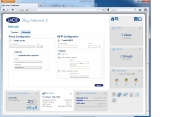Web UI
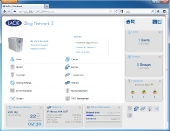 One of the big upgrades to LaCie’s Version 2 of their NAS line is their new OS (dubbed NAS 2.0). It boasts a widget-based interface which is very easy to navigate and use. It’s quite obvious LaCie has aimed this at the “Simple” tech user. The Web-UI has 1 main menu and 12 sub menus. For being a NAS, thats very user friendly and simple. Each “Sub Menu” can occupy a Widget area where it can be easily monitored. Lets take a look at some of the major ones.
One of the big upgrades to LaCie’s Version 2 of their NAS line is their new OS (dubbed NAS 2.0). It boasts a widget-based interface which is very easy to navigate and use. It’s quite obvious LaCie has aimed this at the “Simple” tech user. The Web-UI has 1 main menu and 12 sub menus. For being a NAS, thats very user friendly and simple. Each “Sub Menu” can occupy a Widget area where it can be easily monitored. Lets take a look at some of the major ones.
External Ports
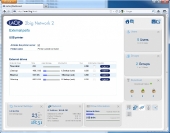 Here is where we can view drives connected via USB to the NAS. This connectivity gives you the option to expand on the share without upgrading the RAID. We also have our print server options and administration in this widget.
Here is where we can view drives connected via USB to the NAS. This connectivity gives you the option to expand on the share without upgrading the RAID. We also have our print server options and administration in this widget.
Shares
In the Shares section we can delegate who has access to which folders, a max space, and what protocals can be used 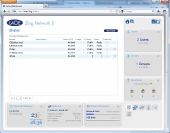 to access them. This is handy when attempting to keep groups seperated. No one wants the interns to have access to the accounting information…
to access them. This is handy when attempting to keep groups seperated. No one wants the interns to have access to the accounting information…
RAID
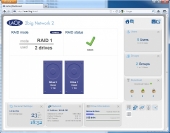 LaCie has given us a graphical representation of our RAID, what mode it is in, if the RAID has been compromised. We have the option of changing between RAID 0 and RAID 1 here on the fly. It will take some time for the board to rebuild the RAID but this is a much easier option than argueing with a bios.
LaCie has given us a graphical representation of our RAID, what mode it is in, if the RAID has been compromised. We have the option of changing between RAID 0 and RAID 1 here on the fly. It will take some time for the board to rebuild the RAID but this is a much easier option than argueing with a bios.
Network
 The 2Big Network 2 can be configured to email a user or admin after completion of a job, download, or if the RAID has been compromised. Another great feature supported is the “Automatic Port Forward.”
The 2Big Network 2 can be configured to email a user or admin after completion of a job, download, or if the RAID has been compromised. Another great feature supported is the “Automatic Port Forward.”
The software can program the Router to forward ALL incoming ports to it. Quite the handy tool if you’re not too savvy around a network or router.
Users and Groups
 LaCie has aimed this at networks of “up to 20 users.” When creating users you can also create groups to easily administrate access to folders. Each user can be associated with an e-mail address to notify of finished downloads/backups. One thing I see as a flaw here is the lack of options in terms of what non-admins can do with administration. General Users do not have access to any of the widgets described via the Web-UI. While I agree with most of that, the Download Manager can be quite a handy tool. More options is all I ask…
LaCie has aimed this at networks of “up to 20 users.” When creating users you can also create groups to easily administrate access to folders. Each user can be associated with an e-mail address to notify of finished downloads/backups. One thing I see as a flaw here is the lack of options in terms of what non-admins can do with administration. General Users do not have access to any of the widgets described via the Web-UI. While I agree with most of that, the Download Manager can be quite a handy tool. More options is all I ask…
Download Manager
As described in the Specifications our NAS can double as a download client. Whether it be a Torrent or a download URL 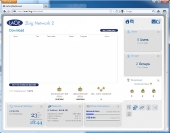 this submenu shows download location, Percent Complete, and download speed. This funcationality is awesome for large files that needed to be downloaded without keeping a desktop on.
this submenu shows download location, Percent Complete, and download speed. This funcationality is awesome for large files that needed to be downloaded without keeping a desktop on.
Eco
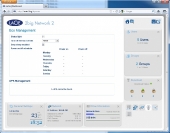 Something that LaCie seems to really be pushing with version 2 of their NAS line is the Eco options and they’ve come through. Here we can setup UPS support, automatic on/off cycles and hard drive downspin timers. We can also turn off the annoyingly bright front status light orb here.
Something that LaCie seems to really be pushing with version 2 of their NAS line is the Eco options and they’ve come through. Here we can setup UPS support, automatic on/off cycles and hard drive downspin timers. We can also turn off the annoyingly bright front status light orb here.
Included backup software
Lacie has included enough backup software to outfit a business. Genie Pro (windows) can backup and image a computer to the NAS 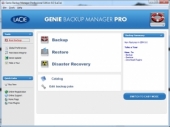 like any other standard backup software. Where it sets it self apart is automatic syncing of a file on the server to a node. So lets say you want to take home a folder of your project every day. At a set time Genie will download that folder from the server to your USB drive or whatever path you decide. Very nice automated options for people who work at home and are forgetful of syncing files.
like any other standard backup software. Where it sets it self apart is automatic syncing of a file on the server to a node. So lets say you want to take home a folder of your project every day. At a set time Genie will download that folder from the server to your USB drive or whatever path you decide. Very nice automated options for people who work at home and are forgetful of syncing files.
File Browser
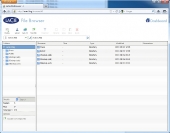 The file browser is the only thing general users have access to in the web interface. Viewing/editing files can either be done via smb share or via the file browser. Here we have options to create, delete, upload and download files to the file system. The browser is java based so running it off of any flavor OS isn’t a problem.
The file browser is the only thing general users have access to in the web interface. Viewing/editing files can either be done via smb share or via the file browser. Here we have options to create, delete, upload and download files to the file system. The browser is java based so running it off of any flavor OS isn’t a problem.
Media Sharing
NAS 2.0 automatically finds and indexs all multimedia content on both the file system and any USB drive connected to it. This is an awesome feature because it shares music/movies/photos via DLNA and DAAP (iTunes) protocals. This means that any media on the system can be played on any DLNA certified system or iTunes client on the same network.
